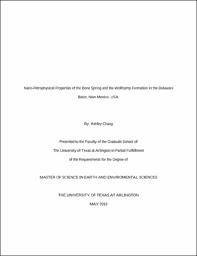
ATTENTION: The works hosted here are being migrated to a new repository that will consolidate resources, improve discoverability, and better show UTA's research impact on the global community. We will update authors as the migration progresses. Please see MavMatrix for more information.
Show simple item record
| dc.contributor.advisor | Hu, Qinhong | |
| dc.creator | Chang, Ashley | |
| dc.date.accessioned | 2019-05-28T20:40:40Z | |
| dc.date.available | 2019-05-28T20:40:40Z | |
| dc.date.created | 2019-05 | |
| dc.date.issued | 2019-05-09 | |
| dc.date.submitted | May 2019 | |
| dc.identifier.uri | http://hdl.handle.net/10106/28100 | |
| dc.description.abstract | The Permian Basin is one of the largest oil producing basins in the United States. The Permian Basin is 260 miles by 300 miles in area and encompasses 52 counties in southeast New Mexico and West Texas. In the past decade, the Permian Basin has exceeded its previous peak from the early 1970s (EIA, 2018). Now, the basin has generated more than 33.4 billion barrels of oil and roughly 118 trillion cubic feet of natural gas (EIA, 2018). The Permian Basin is a very complex sedimentary system, with three main sub-divisions that are geologically and stratigraphically different from one another. These three sub-divisions are the Midland Basin, Central Basin Platform and the Delaware Basin. The Delaware Basin, specifically the Bone Spring and Wolfcamp Formations, will be the focus of this study.
Although the production in the Permian Basin has been accelerating, the steep decline rate in the production of the basin is a realistic concern. To better understand the factors contributing to the production decline rate, this study will investigate the pore structure and fluid migration within the Bone Spring and Wolfcamp Formations. Seven samples from the Wolfcamp Formation are studied, along with two samples from the First Bone Spring unit and one sample from the Second Bone Spring unit. The methods used in this investigation include: total organic carbon (TOC) analysis and pyrolysis for the geochemistry, x-ray diffraction (XRD) to determine the mineralogy, vacuum saturation and liquid displacement, mercury intrusion capillary pressure (MICP) measurements of the sample’s petrophysical properties (such as porosity, pore size distribution, tortuosity and permeability), and spontaneous imbibition to determine the pore connectivity in DI water and DT2 (n-decane: toluene= 2:1 in volume) fluids.
The results from the methods stated above show that samples from the Wolfcamp and Bone Spring Formations are quartz or carbonate rich and have TOC values that range from 0.08-1.96%. The porosity of all samples range between 0.36-7.65%. Most samples have pores that are in the micro-fracture and intergranular pore range (>100 nm), with only three samples falling within the intragranular, organic matter, and inter-clay platelet pore range (2.5-50 nm). The samples with a predominant pore-throat network interval of 2.8-50 nm have a permeability that ranges from 0.55 nD to 294 nD, and a geometrical tortuosity that ranges from 2.7-85.2. Samples that have a predominant pore-throat network of >100 nm have a range of 2.55E4 nD to 6.02E9 nD in permeability, and a geometrical tortuosity range of 0.2-5.3. Three out of the 10 samples display a good pore connectivity towards DT2 fluid, and all samples show poor pore connectivity with DI water. | |
| dc.format.mimetype | application/pdf | |
| dc.language.iso | en_US | |
| dc.subject | Delaware Basin | |
| dc.subject | Wolfcamp | |
| dc.subject | Bone Spring | |
| dc.subject | Permian Basin | |
| dc.title | Nano-Petrophysical Properties of the Bone Spring and the Wolfcamp Formation in the Delaware Basin, New Mexico, USA. | |
| dc.type | Thesis | |
| dc.degree.department | Earth and Environmental Sciences | |
| dc.degree.name | Master of Science in Earth and Environmental Science | |
| dc.date.updated | 2019-05-28T20:40:40Z | |
| thesis.degree.department | Earth and Environmental Sciences | |
| thesis.degree.grantor | The University of Texas at Arlington | |
| thesis.degree.level | Masters | |
| thesis.degree.name | Master of Science in Earth and Environmental Science | |
| dc.type.material | text | |
| dc.creator.orcid | 0000-0002-0300-5590 | |
Files in this item
- Name:
- CHANG-THESIS-2019.pdf
- Size:
- 2.902Mb
- Format:
- PDF
This item appears in the following Collection(s)
Show simple item record


